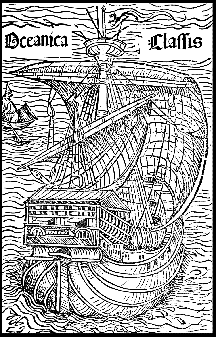|
For the past few years, Panamanian salvage divers have been recovering remains
of the wooden hulk of a wrecked Spanish caravel, found in 1997 under 6 meters
of water at the Caribbean port of Nombre de Dios. Little by little,
archaeologists from the National Cultural Institute of Panama at nearby Porto
Bello have accumulated evidence that this may have been one of four ships
used by Columbus during his last voyage in 1502-1503, when the Genoese mariner
sailed along the coast from Honduras to Panama.
 On May 9, 1502,
Columbus and 135 men left the Spanish port of Cadiz with a small fleet of
four caravels named La Capitana, Santiago de Palos, La Gallega, and La
Vizcaína (Morison 1942). Caravels (fig.1) were high, square-rigged
ships about 60-70 ft long, with 50-70 tons cargo capacity. Other examples
were the Niña and the Pinta of Columbus’s first voyage (see AR
1,3 p.39). By July 30 the Spaniards had reached the Bay Islands
off Honduras, where they encountered Maya-like traders carrying textiles,
cacao beans, and copper implements in large canoes with awnings (see AR
2,1, p.33). As reported in the memoirs of Columbus’ nephew Ferdinand
Colón, the Spanish ships then turned east along the so-called Costa
de las Orejas (“coast of the ears”), named for the long earlobes
of Jicaque and Payan natives wearing egg-sized earspools. On May 9, 1502,
Columbus and 135 men left the Spanish port of Cadiz with a small fleet of
four caravels named La Capitana, Santiago de Palos, La Gallega, and La
Vizcaína (Morison 1942). Caravels (fig.1) were high, square-rigged
ships about 60-70 ft long, with 50-70 tons cargo capacity. Other examples
were the Niña and the Pinta of Columbus’s first voyage (see AR
1,3 p.39). By July 30 the Spaniards had reached the Bay Islands
off Honduras, where they encountered Maya-like traders carrying textiles,
cacao beans, and copper implements in large canoes with awnings (see AR
2,1, p.33). As reported in the memoirs of Columbus’ nephew Ferdinand
Colón, the Spanish ships then turned east along the so-called Costa
de las Orejas (“coast of the ears”), named for the long earlobes
of Jicaque and Payan natives wearing egg-sized earspools. Fig.1: Drawing of a Spanish Caravel ca. 1493 (Letter of Columbus,
Lenox Library).
Sailing south from Honduras to Panama (often amid bad weather and contrary
winds), and landing at a few shore points to barter for gold ornaments, in
January 1503 the Spaniards stopped at the mouth of the Río Belén.
There, learning of rich gold sources through local Guaymis, they attempted
to found a colony called Santa Maria de Belén. By the spring of 1503,
however, hostilities had commenced with parties of Quibián (Guaymi)
warriors. The Spaniards took hostages, and a boatload of Spaniards were killed
a few miles up the Río Belén. Columbus decided to evacuate,
and after abandoning one of the ships (the Gallega) which had been careened
behind a sandbar, sailed from Belén on April 16, 1503.
A week later, upon reaching Porto Bello, the Vizcaina was leaking so badly
from wormholes it too was abandoned, and on April 23, 1503 the Spaniards
crowded into the remaining two ships and sailed for home. It is the scuttled
remains of the Vizcaina which Portobello archaeologists now think they have
found. Artifacts from the wreck seem consistent with this theory. Lying on
a shallow sandbank, the twin-masted, wooden caravel hulk still held its anchors,
but had been stripped of all rigging and material possessions of the crew.
Archaeologists from the Instituto Cultural, working with salvagers from Conquest
Panama Inc. and Investigaciones Marinas del Istmo S.A, believe this shows
evidence of deliberate abandonment or scuttling. A variety of other details
on hull construction, cannon types, pottery, and food remains all appear
to corroborate that this ship may indeed be La Vizcaina. Stone cannonballs
were among the first artifacts recovered from the site. Five cannons of two
early types called Versos and Lombards were left on deck, now encrusted with
coral and barnacles. The swivel-mounted, breach loading Lombard was a fault-prone
weapon known to have been used on Columbus’ expeditions. Due to their
tendency to misfire (and sometimes blow up the shooter), the Spanish stopped
using them after about 1520.
Construction details have also helped date the ship. Its hull timbers, hammered
together with wooden pegs, were not sealed in lead, which protected the hulls
against wood-boring worms (such as had infested all four ships on the 1502-3
voyage). Lead sheathing became mandatory among Spanish shipbuilders by royal
decree in 1508. Sherds from pottery amphorae for olive oil, typical of early
16th century New World voyages, have also come from the sunken vessel. Food
remains including coconut husks and shellfish show Spaniards were living
off local resources by the time they reached the spot where they abandoned
La Gallega. Based strictly on chronology, the wreck could also be that of
a ship known to be lost by Francisco Pizarro en route to Cartagena, Colombia
as part of the attempt by Alonzo de Ojeda to colonize that region (1508-1509).
Whether or not it is confirmed to be La Vizcaina, it would in any case be
the first ship to be found from the early part of the Spanish Conquest, for
which there are few contemporary images or related material remains.
References: .
Colon (Columbus), Christopher, 1493. Letter . Lenox Library.
Colon (Columbus), Fernando, 1530.
Journals.
Gaynor, T. 2001 The Guardian (5 Nov. 2001). Morison, Samuel E., 1942. Admiral of the Ocean Sea. “New
World Explorers I: The First Voyage of Columbus,” Athena Review
Vol. 1, no. 3 (1997). “New World Explorers II: The Fourth Voyage of
Columbus,” Athena Review, Vol. 2, no. 1 (1998).
This article appears in the Recent Finds in Archaeology section of Vol.3, No.2 of Athena
Review.
.
|
|